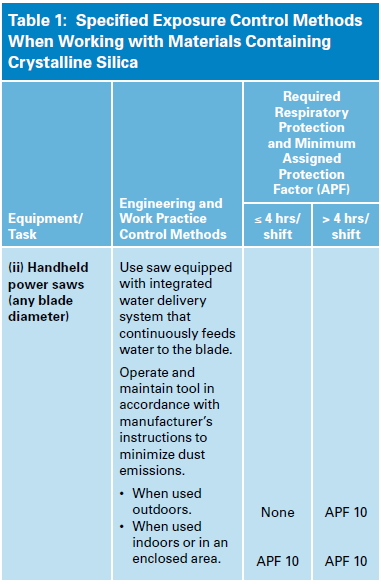Crystalline Silica Update
OSHA is issuing two standards to protect workers from exposure to respirable crystalline silica – one for construction, and the other for general industry and maritime – in order to allow employers to tailor solutions to the specific conditions in their workplaces.
Who is affected by the construction standard?
Exposure to respirable crystalline silica can cause silicosis, lung cancer, other respiratory diseases, and kidney disease. Exposure can occur during common construction tasks such as using masonry saws, grinders, drills, jackhammers and handheld powered chipping tools; operating vehicle-mounted drilling rigs; milling; operating crushing machines; and using heavy equipment for demolition or certain other tasks.
The construction standard does not apply where exposures will remain low under any foreseeable conditions; for example, when only performing tasks such as mixing mortar; pouring concrete footers, slab foundation and foundation walls; and removing concrete formwork.
What does the standard require?
The standard requires employers to limit worker exposures to respirable crystalline silica and to take other steps to protect workers.
The standard provides flexible alternatives, especially useful for small employers. Employers can either use a control method laid out in Table 1 of the construction standard, or they can measure workers’ exposure to silica and independently decide which dust controls work best to limit exposures to the PEL in their workplaces.
Regardless of which exposure control method is used, all construction employers covered by the standard are required to:
Establish and implement a written exposure control plan that identifies tasks that involve exposure and methods used to protect workers, including procedures to restrict access to work areas where high exposures may occur.
Designate a competent person to implement the written exposure control plan.
Restrict housekeeping practices that expose workers to silica where feasible alternatives are available.
Offer medical exams—including chest X-rays and lung function tests—every three years for workers who are required by the standard to wear a respirator for 30 or more days per year.
Train workers on work operations that result in silica exposure and ways to limit exposure.
Keep records of workers’ silica exposure and medical exams.
Table 1 matches common construction tasks with dust control methods, so employers know exactly what they need to do to limit worker exposures to silica. The dust control measures listed in the table include methods known to be effective, like using water to keep dust from getting into the air or using ventilation to capture dust. In some operations, respirators may also be needed.
Employers who follow Table 1 correctly are not required to measure workers’ exposure to silica and are not subject to the PEL.

For reference, see https://www.osha.gov/silica/SilicaConstructionRegText.pdf
Alternative exposure control methods
Employers who do not use control methods in Table 1 must:
Measure the amount of silica that workers are exposed to if it may be at or above an action level of 25 μg/m3 (micrograms of silica per cubic meter of air), averaged over an eight-hour day.
Protect workers from respirable crystalline silica exposures above the permissible exposure limit of 50 μg/m3, averaged over an eight-hour day.
Use dust controls to protect workers from silica exposures above the PEL.
Provide respirators to workers when dust controls cannot limit exposures to the PEL.
When are employers required to comply with the standard?
Construction employers must comply with all requirements of the standard by September 23, 2017, except requirements for laboratory evaluation of exposure samples, which begin on September 23, 2018.





